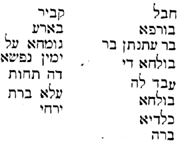
|
|||
|
[ Previous ][Contents][ Next ] |
|||
|
that the Alif preverved in Hebrew, Aramaic and Phoenician has disappeared
in the Palmyrene
orthography, but it is possible that the god Malakbel came to Palmyra from
Arabia and there we find as
the word for "angel" not only "mal'âk", but also malak, with contraction
of the Alif.(6O) A
pronunciation and meaning of the name in our inscription identical with the
divine name Malakbel, "the
messenger of Bel", would be inconceivable. It must, therefore, be
interpreted in another way and the
most likely explanation is, that it is composed of Bel and the widely used
Semitic word, malak, "king".
Such a name, meaning "Bel is king"(60a) could be pronounced Malakbel, but
would, however, seem
impractical being too close to or identifical with that of the divine name
Malakbel ; or it could be
pronounced Malkibel, in favor of which one
Male bust with Palmyrene inscription, eight lines to the right and seven to the left of the head (pl. IX, 2):  "Alas! Bôrfâ, son of 'Atenatan, son of Bôlhâ, which his son Bôlhâ, the Chaldean, made for him. This funerary stele was entombed in the lower part of the niche to |
|||
|
|||
|
[ Previous ][Contents][ Next ] |
|||
|
Created by the Digital
Documentation Center at AUB
in collaboration with Høgskolen i
Østfold, Norway. 980519 pas - Email: hseeden@aub.edu.lb |